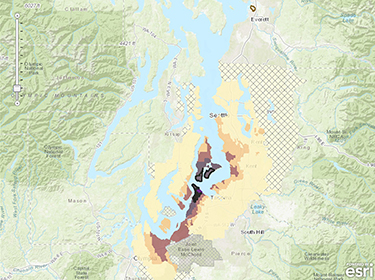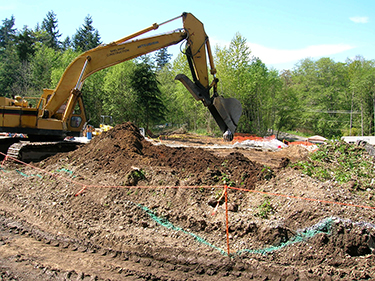|
Subscribe / Renew |
|
|
Contact Us |
|
| ► Subscribe to our Free Weekly Newsletter | |
| home | Welcome, sign in or click here to subscribe. | login |
Real Estate
| |
 |
June 28, 2018
Advice for developers: Know what's below first
Landau Associates

Marder
|
It had 2.5 million bricks, 5,000 tons of mortar and was 571 feet tall.
In 1917, the largest smokestack in the world stood as a symbol of engineering excellence. The plant was capable of processing massive amounts of copper and was one of Pierce County’s largest employers. And yet, only 100 years later, the smokestack and its plant have been demolished, leaving a legacy of pollution in its wake.
The Tacoma Smelter caused pollution of arsenic, lead and other heavy metals across a 1,000-square mile area, known as the Tacoma Smelter Plume. Even decades later, much of the area still has elevated concentrations of these contaminants in the soil, which causes restrictions and additional work for developers who would like to develop property in the rapidly growing area.
History of the plume
The plant site was originally a lead-refining company established in 1888. It was sold in 1905 to American Smelter and Refining Co. (Asarco), and became a copper smelter in 1912. After years of operation — and pollution — the smelter was demolished in 1993.
In 2009, Asarco was held accountable for $1.79 billion for past and future cleanup for over 100 locations across the U.S., $94.6 million of which was designated for Tacoma. To date, the state Department of Ecology has overseen replacement of soil for 245 properties in the plume area (with more planned soon), and dozens of other properties have been remediated by private entities.
Exposure to arsenic and lead can be harmful, especially to children and people with weakened immune systems. Because of the pervasive and expansive nature of the soil contamination, there are strict requirements for site development including health and safety protocols.
Cleanup through development
One of the lasting impacts of the plume is how it affects site development. Even just a couple of counties over, there are fewer requirements for developers to get final approval to sell property compared to developers within the plume. The requirements within the plume stem from Ecology’s State Environmental Policy Act checklist process, which is usually triggered by development activities.
As part of the SEPA checklist, if the project is located within areas of the plume where average soil concentrations exceed state cleanup standards for arsenic or lead, developers or property owners are required to perform site characterization sampling to verify soil concentrations.
If concentrations exceed state cleanup standards, cleanup activities are required for development to proceed.
According to state cleanup rules, arsenic levels in the soil must be less than 20 parts per million and lead levels must be less than 250 ppm to be considered safe.
In most cases, developers are aware of the contamination prior to purchasing the property and know the steps needed to correct it. However, the requirement comes as a surprise to some property owners who are redeveloping property they have owned for some time.
Ecology approval process
When sampling and/or cleanup are required, developers and property owners often contract with an environmental consulting firm who will perform site characterization sampling, evaluate results, and make recommendations on how to most efficiently incorporate cleanup activities (if required) with the site development activities. The consultant will ensure that the sampling and cleanup recommendations meet Ecology’s guidelines.
Once the consulting firm has evaluated results and determined whether cleanup is required, a report is submitted to Ecology on behalf of the developer or property owner. Ecology reviews the report and issues an opinion on the adequacy of the site characterization sampling program and proposed cleanup plan.
That opinion is typically sufficient to obtain permit approvals from local agencies. However, completion of required cleanup activities is often required to close out permits or to de-list the site with Ecology.
If cleanup occurs over an entire property, Ecology will typically issue a “no further action” (NFA) determination upon completion of cleanup; an affirmation that the cleanup has met state guidelines and cleanup criteria.
In cases where development occurs on only a portion of a large property and it would be costly and time-consuming to complete cleanup of the whole property, Ecology may issue an opinion letter affirming the adequacy of the cleanup that was conducted on a portion of the property. However, additional characterization and cleanup will usually be required as additional areas of the property are redeveloped. For instance, Landau Associates has assisted clients with testing on only part of the property and submitted a report on that portion to Ecology to facilitate development in a timely manner.
Expert advice
While it can seem complicated, the characterization and cleanup process is typically straightforward for knowledgeable environmental consulting firms and is a relatively fast process for the developer.
Working with a qualified environmental consultant that is experienced with specialized guidance for site characterization and remediation within the plume can mean the difference between a straightforward permitting process and significant project delays.
Hydrogeologist Christine Kimmel and Jennifer Wynkoop, both of Landau Associates, have guided developers through the process of securing NFAs and opinion letters for numerous sites within the plume.
“We advise developers on how to most efficiently complete cleanup as part of the site development activities,” Kimmel says. “These sites are different than most other cleanup sites, and improper advice on how to manage impacted soil can result in excess time and expense for developers.”
Wynkoop says this can result in “lower property value and make the property more difficult to sell.”
Additionally, improper sampling and reporting techniques can lead Ecology to reject work plans or reports, and thus not provide developers with timely approvals needed to obtain permits. If a report is rejected, the developer may be required to complete additional sampling or start the whole sampling process over again, wasting time and money in the process.
Resources
For developers working within the plume, as well as the public, Ecology has an online interactive map that shows estimated levels of arsenic on property. The website also provides information on soil sampling, buying and selling real estate, and literature for developers and property owners. It can be found at https://tinyurl.com/EcologyPlume.
Rebecca Marder is a marketing assistant at Landau Associates, an environmental consulting firm with offices in Seattle, Tacoma, Edmonds, Olympia, Spokane and Portland.
Other Stories:
- Why local developers are bullish on Tacoma
- Tacoma getting first Vietnamese-funded housing in U.S.
- Tacoma invests in venues to spur tourism
- City of Destiny’s ‘time to make it’ has come
- Horizon Partners taps another historic renovation
- Industrial: South Sound is a ‘goldmine’
- Multifamily: Seattle's hot market pushes south
- Office: Vacancy rates down, rents rising
- Sound Transit gets on board with more tracks




